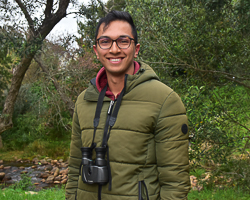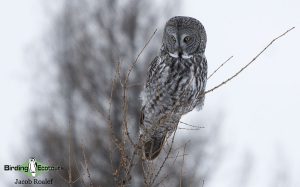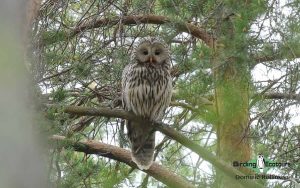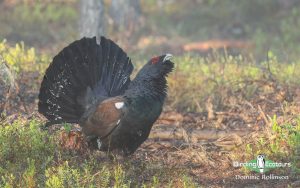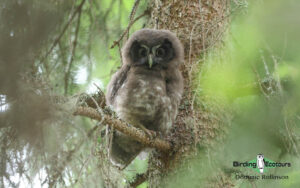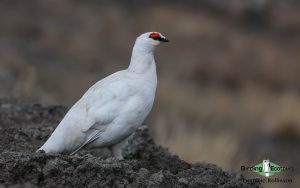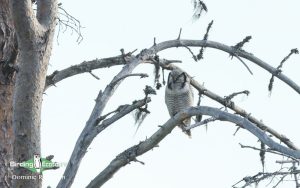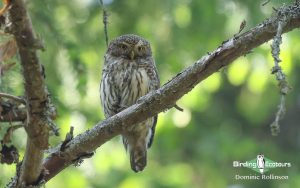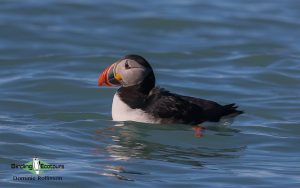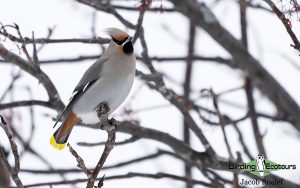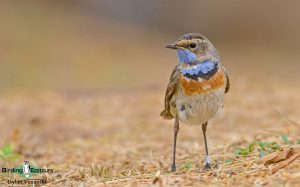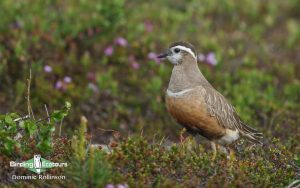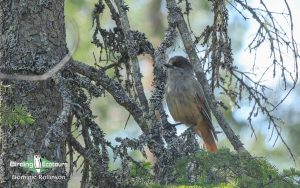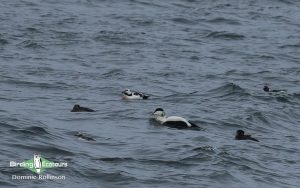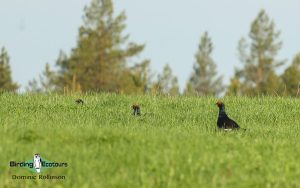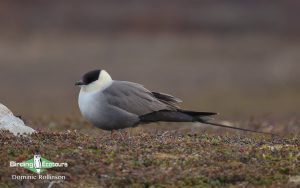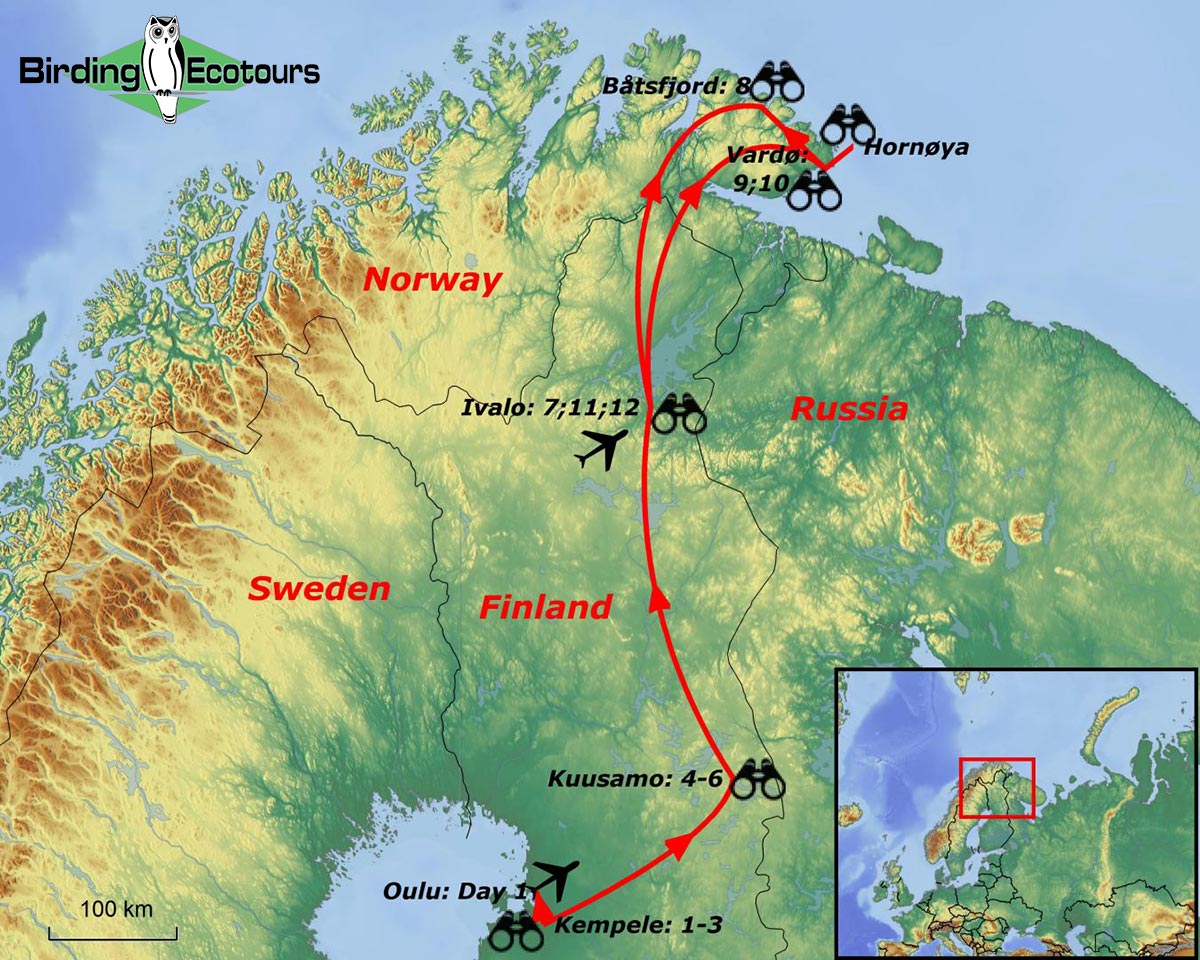Birding Tour Finland and Norway: Taiga and Tundra Adventure
Birding Tour Finland & Norway : Taiga and Tundra Adventure
June 2026/ May 2027
There has been a long-held mysticism among birders regarding the northern part of Finland and Norway. The area conjures up images of vast forests, biting temperatures, and months of darkness. The reality is that the north of both Finland and Norway are two of Europe’s premier birding locations and our Taiga and Tundra Adventure will showcase just that, with the bonus of 24 hours of daylight to maximize our birding experiences. While it is true that there are vast swathes of taiga forest, there are also stunning fjords, miles of breathtaking tundra, rocky mountain peaks, otherworldly coastlines, and charming fishing villages to enjoy. Moreover, there is a simply fantastic selection of wildlife, no more so than the avifauna of the region. This tour will cover the full range of habitats available as we make our way through Lapland’s vast emptiness before joining the breathtaking Varangerfjord and exploring its length in its entirety.
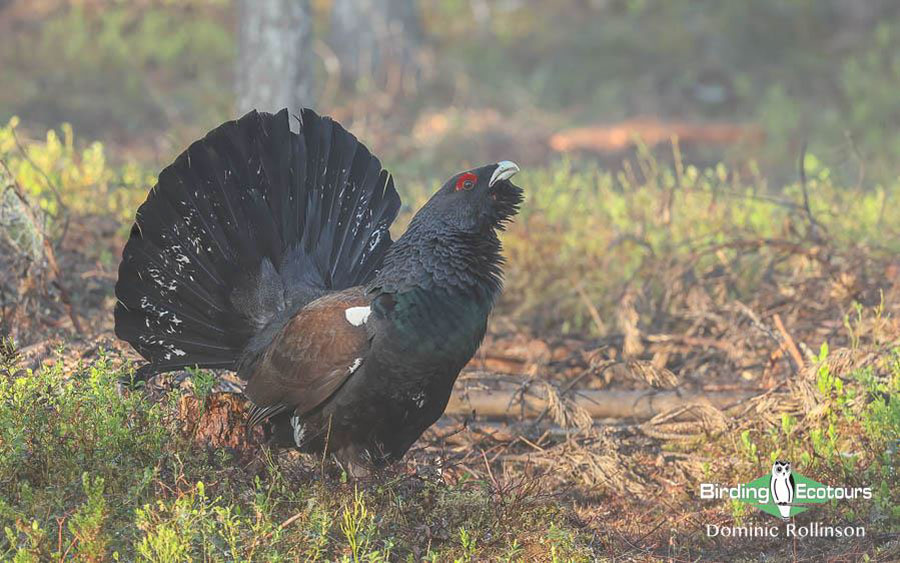
Birding in the northern latitudes presents its own unique set of experiences. June in the region is surprisingly dry, as this area of Finland and Norway is sheltered from the Atlantic currents that bring lots of rain up through Scandinavia. This means that we will generally find good weather which, combined with the midnight sun, will give a lot of birding hours to enjoy. These northern latitudes do not have the sheer number of species you will find further south in Europe, but the climate and environment has led to a fascinating diversity of highly sought-after species that thrive in these areas.
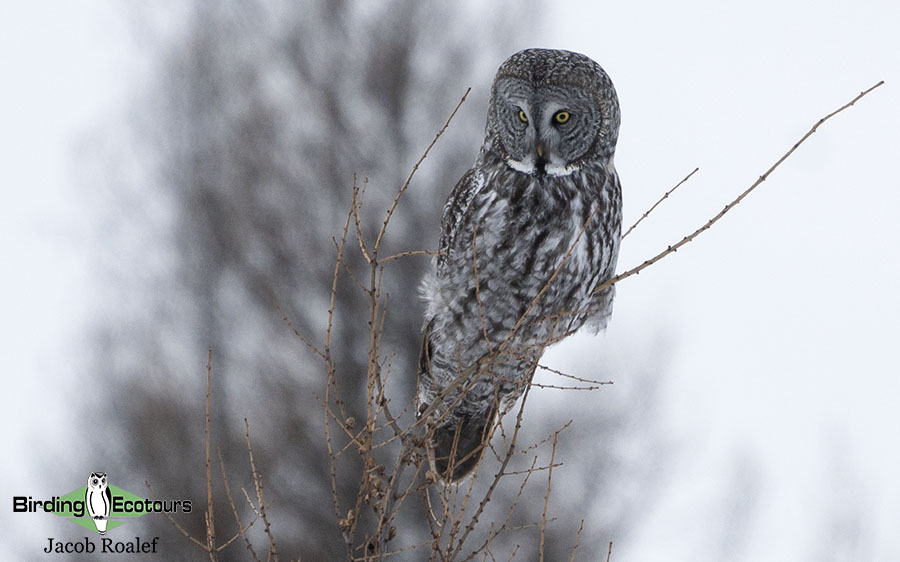
We will begin our tour in the city of Oulu in central Finland. Over the first three days of the tour we will explore the vast forests of the area. These forests are arguably the best in Europe for breeding owls and they will be the focus of the first part of our tour. With the aid of excellent and knowledgeable local guides, we hope to come across a number of highly desired owl species. Whichever species we see will no doubt be an unforgettable experience, as is always the case with this charismatic family of birds. The chances of seeing our owl targets on this tour relies very heavily on the concentrations of voles, which varies each year. Some years are considered bad vole years, which means there are fewer breeding owls around, while in some years vole numbers may be high, which increases our chances of finding our owl targets! The forests around Oulu are also home to a range of other fascinating species, including Black Woodpecker, Eurasian Three-toed Woodpecker, Wood Warbler, and Rustic Bunting, amongst others.
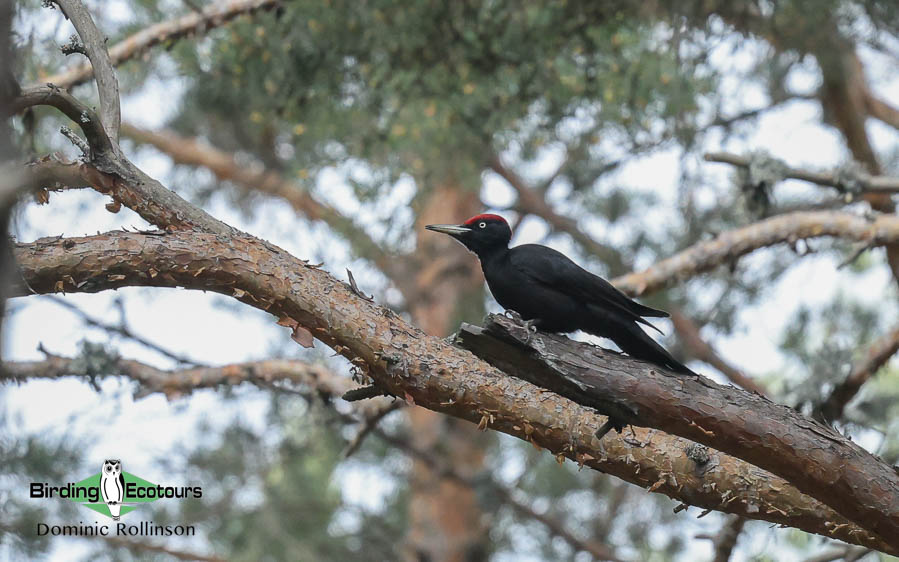
While around Oulu we will explore Liminganlahti. This superb wetland area plays host to many wildfowl and shorebird (wader) species. Highlights of our time here will likely include Spotted Redshank, Caspian Tern, Black-tailed Godwit, Garganey, Whooper Swan, and Common Crane. This activity is an irresistible lure to multiple birds of prey including White-tailed Eagle, Western Marsh Harrier, and Peregrine Falcon. Rarer species that we have a chance of coming across here include shorebirds (waders) like Broad-billed Sandpiper and the delicate Pallid Harrier, one of Europe’s rarest (and most attractive) breeding birds of prey whose presence in the area is reliant on the concentrations of voles. We should also be well timed to witness the fascinating Ruff leks that occur in the area every summer.
We will then head east across the breadth of Finland to the city of Kuusamo, close to the Russian border. Along the route we will explore the vast swathes of lakes that form Finland’s interior. Here we may come across Smew, Common Crane, Common Scoter, and Eurasian Whimbrel, among others. The variety of birds here is extensive, and as we continue to explore, we will come across small groups of Common Goldeneye, singing Wood Sandpiper, and stunning Brambling. This area of Finland is home to several eastern species of birds, including Red-flanked Bluetail, Rustic Bunting, and Little Bunting. Taiga forest specials occur here too, including Grey-headed Chickadee (Siberian Tit), Siberian Jay, and the tricky Two-barred Crossbill. Our primary targets while birding around Kuusamo are the various grouse species, and we hope to find lekking Western Capercaillie and Black Grouse, as well as Hazel Grouse.
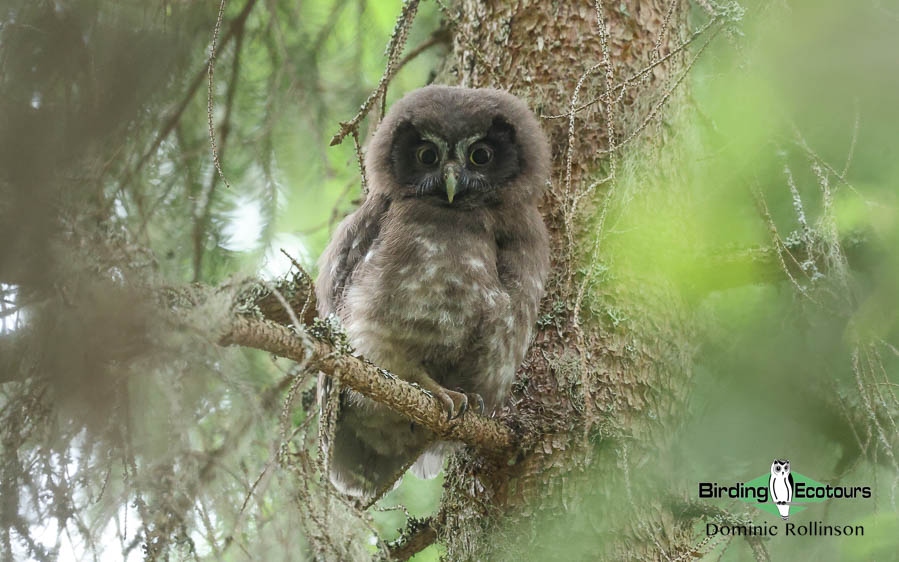
From Kuusamo we drive north, crossing the Arctic Circle, heading through beautiful taiga forests to Ivalo. From Ivalo we continue our journey north (often enjoying Pine Grosbeak at a feeding station en route) and eventually cross into Norway. The landscape changes into boggy fells as the Arctic tundra begins to reveal some of its stunning birdlife, such as Black-throated Loon (Diver), Bluethroat, Rough-legged Buzzard, and European Golden Plover. The Tana River and delta should hold numbers of Common Merganser (Goosander), plus breeding Temminck’s Stint, and small numbers of Bar-tailed Godwit.
After exploring the river, we head up to the northern harbor town of Båtsfjord on the north coast of Varanger. The high tundra en route is home to specials such as Rock Ptarmigan, Long-tailed Jaeger (Skua), Eurasian Dotterel, Arctic Redpoll, and Lapland Longspur (Lapland Bunting). While in the highlands, temperatures often hover around freezing, however, the birding is normally exceptional with many new trip birds as we make our way through the tundra. The tundra areas here also hold Rough-legged Buzzard, Parasitic Jaeger (Arctic Skua), Short-eared Owl, Bluethroat, Horned (Shore) Lark, and Snow Bunting.
The final leg of our tour is on the stunning Varangerfjord itself. Along the route we will scan the tundra pools for shorebirds (waders) like Eurasian Whimbrel, Red-necked Phalarope, Temminck’s Stint, Little Stint, and Bar-tailed Godwit. These lakes and pools are also home to breeding Red-throated and Black-throated Loons (Divers). Further into the fjord we will explore coastal sites for some special wildfowl. With luck, the flocks of Common Eider may still have a few King Eider and Steller’s Eider (two amazing sea ducks), although most of these birds would have already moved off to their breeding grounds further east.
We will explore the peninsula’s superb seabird colonies. The remote island of Hornøya, off the coast of Vardø, is something to behold. The rocky island is home to 25,000 pairs of Black-legged Kittiwake, plus around 150 pairs of European Shag. The island is also covered in alcids such as Thick-billed Murre (Brünnich’s Guillemot), Common Murre (Guillemot), Razorbill, and Atlantic Puffin. This activity attracts the two principal birds of prey here, the massive White-tailed Eagle and the scarce Gyrfalcon.
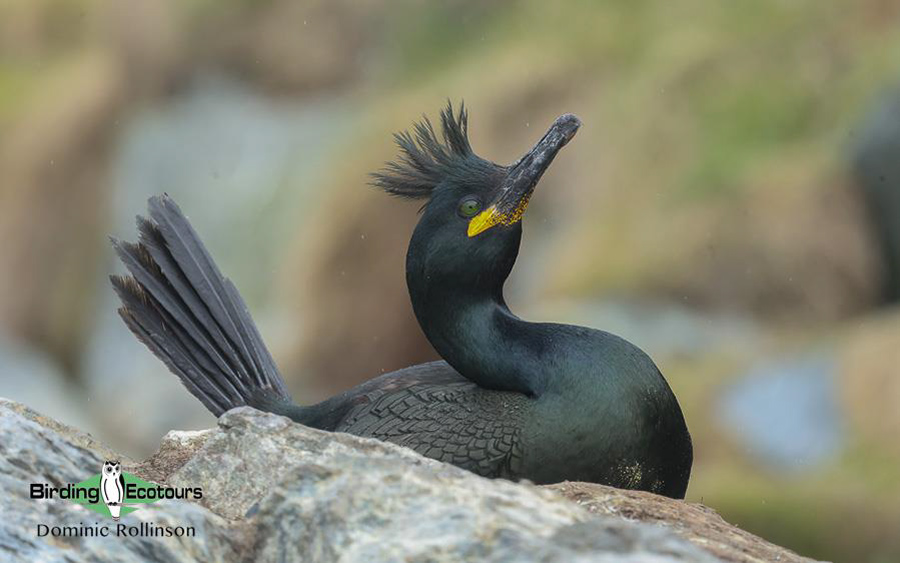
From here we will make the journey back to Ivalo, stopping for birding en route, before drawing our tour to a close. This journey will see us head further east than Istanbul in Turkey and as far north as the Arctic Circle. This Scandinavian birding tour is one you do not want to miss!
Itinerary (12 days/11 nights)
Days 1 – 3. Arrival in Oulu, birding the Liminganlahti wetlands and the Oulu region
Welcome to the land of the midnight sun. You will be met in Oulu by your Birding Ecotours tour leader and expert Finnish local guide. Our first evening in Oulu will be spent getting settled into our hotel and enjoying a traditional Finnish meal. Here we will discuss the trip and use the time to assist with anything the group may need.
We will spend the first three days of our tour in the area surrounding the city of Oulu. This city of around 200,000 inhabitants is the largest in northern Finland and will be our base for the next few days. Oulu happens to be surrounded by some of the best birding Finland has to offer and we will use the long hours of daylight to maximize the birding experiences. Here, we will explore the dense taiga forests in search of some of the amazing species that inhabit this vast wilderness. The Oulu region is one of the best in Europe for breeding owls and we will attempt to see a number of charismatic owl species here.
The smallest of these species is the Eurasian Pygmy Owl. Despite its small size this species is a voracious, mainly diurnal hunter, and often hangs around bird feeders and hunts in a fashion like that of small hawks. Another small owl species here is the Boreal (Tengmalm’s) Owl. This species can be incredibly elusive, and our best bet will be to observe this species near nest sites. In more open habitats, we hope to come across Short-eared Owl, although this species often requires some luck to find.
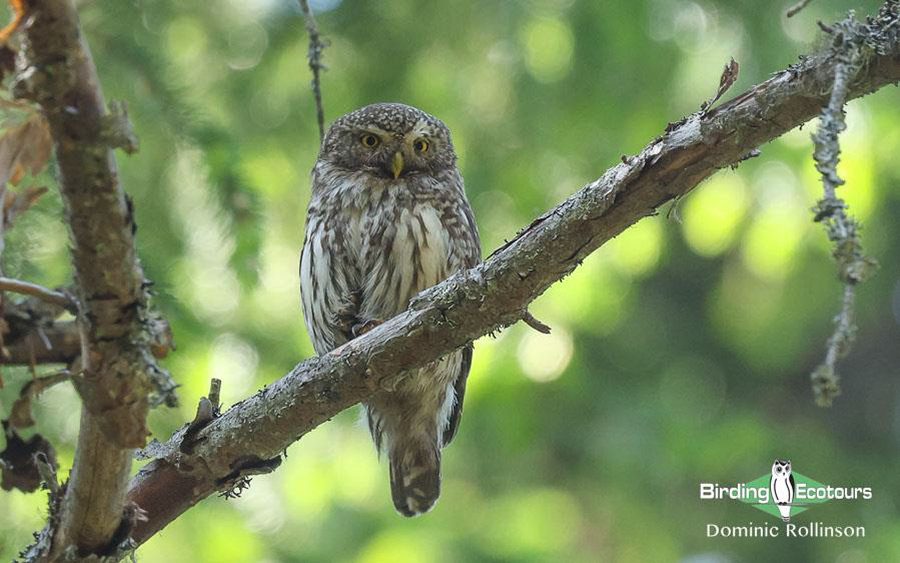
Ural Owl and Great Grey Owl dwarf the other owl species here, but this does not necessarily make them any easier to see, though with our excellent local team we will stand a good chance! We will spend plenty of time searching the forests for these two mighty species. There is sometimes the possibility of seeing Eurasian Eagle-Owl too, however, as they are extremely sensitive breeders, we do not visit nesting sites, and so are reliant on finding roosting birds. While the owl species are the real highlight of the forests, they are not the only amazing species to be found here. The taiga forests in June come alive as the daylight hours increase. By exploring the forest trails here, we should come across forest specials such as Black Woodpecker, Eurasian Three-toed Woodpecker, Lesser Spotted Woodpecker, Grey-headed Woodpecker, and perhaps Eurasian Goshawk.
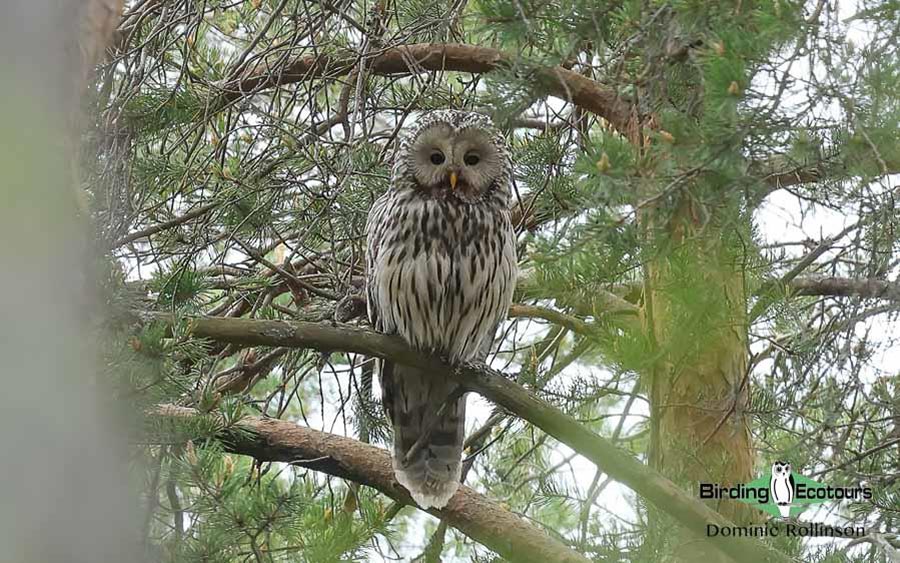
Passerines of the forest can be numerous in June, and we will search for Bohemian Waxwing, European Crested Tit, Great Grey Shrike, Common Rosefinch, Fieldfare, Tree Pipit, Brambling, Red (Common) Crossbill, Eurasian Siskin, and Yellowhammer. Forest birding can be challenging but this makes the rewards even greater and the forests around Oulo offer some sensational species for us to enjoy.
Another area we will explore during the first three days of the tour is the wetlands of Liminganlahti, situated to the south of Oulu. This wetland site is home to a multitude of wildfowl and shorebirds, including Eurasian Curlew, Common Greenshank, Spotted Redshank, Ruff, Caspian Tern, Black-tailed Godwit, Northern Shoveler, Red-breasted Merganser, and Garganey. Additionally, hundreds of young (non-breeding) Whooper Swans and Common Cranes spend their summer in the bay area. Usual sightings here also include White-tailed Eagle and Western Marsh Harrier, while Peregrine Falcon is a regular visitor from the nearby bog. Terek Sandpiper and Pallid Harrier are much sought-after rare breeding birds in the Oulu area.
During other excursions into forested areas there might be a chance to find Wood Warbler, Thrush Nightingale and Blyth’s Reed Warbler – and perhaps even Corn Crake, and Marsh Warbler. It is fair to say that all these species have incredible songs and will provide more tour highlights.
Overnight (three nights): Finlandia Hotel Airport Oulu, Kempele, Finland
Days 4 – 6. Birding the Kuusamo region
After three action-packed days around Oulu we will spend Day 4 undertaking our journey towards the beautiful northern regions of Finland. En route we will travel through stunning landscapes blanketed with forests, bogs, lakes, and rivers, with our end destination being the city of Kuusamo on the border with Russia.
Along the way we will stop at convenient points to do some birding around the wet bogs and lakes. In these areas we may come across Smew (one of the best-looking ducks on the planet), Velvet Scoter, Common Scoter, Common Crane, Osprey, Eurasian Whimbrel, Green Sandpiper, Common Goldeneye, Wood Sandpiper, and Little Gull, among others.
As we approach Kuusamo these lakes and bogs are broken up by sections of taiga forest. These are a real draw for species such as Willow Tit, Common Cuckoo, Hooded Crow, Great Spotted Woodpecker, Brambling, Bohemian Waxwing, and Eurasian Siskin.
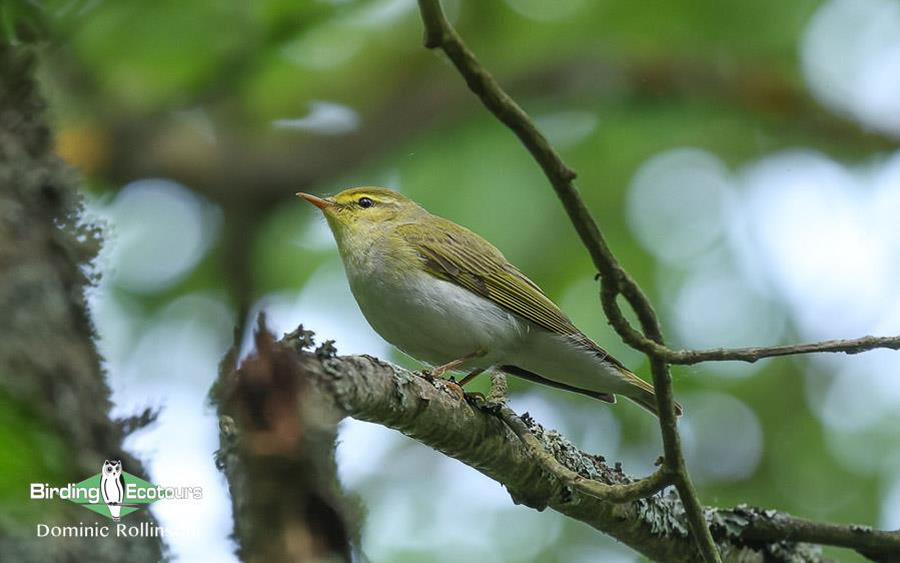
Once in Kuusamo we will explore the superb habitats of the region around the town. The real draw of this region is the grouse species which can be seen at traditional lekking sites. Grouse targets here include Black Grouse, Western Capercaillie, and Hazel Grouse. To find these grouse at their lekking sites we will need very early morning starts (around 3:30 am) to ensure we are on site before it warms up! We also look for several other species which are very range-restricted in Europe around Kuusamo, such as Red-flanked Bluetail, Rustic Bunting, Little Bunting, and Grey-headed Chickadee (Siberian Tit). These are all beautiful species and a huge bonus of birding in the area.
We also hope to be able to add to the above with some real forest specials such as Siberian Jay, Parrot Crossbill, Pine Grosbeak, and Black Woodpecker. The grassland sections between the forests often hold Rough-legged Buzzard, and Common Rosefinch.
Another important target around Kuusamo (and as we head further north) is the striking Northern Hawk-Owl. This species is a real star of the taiga forest and it is often seen on roadside wires scanning the grasses for small mammals. It is one of the few owls to be solely diurnal and this will help us locate this species. The habitats closer to Kuusamo will provide us with a different range of species to those found nearer Oulu such as Red-necked Grebe, Spotted Redshank, and Jack Snipe. Exploring the surrounding forests will give us another chance of spotting Northern Hawk-Owl and Boreal (Tengmalmn’s) Owl, plus Western Capercaillie, Black Grouse, and Hazel Grouse.
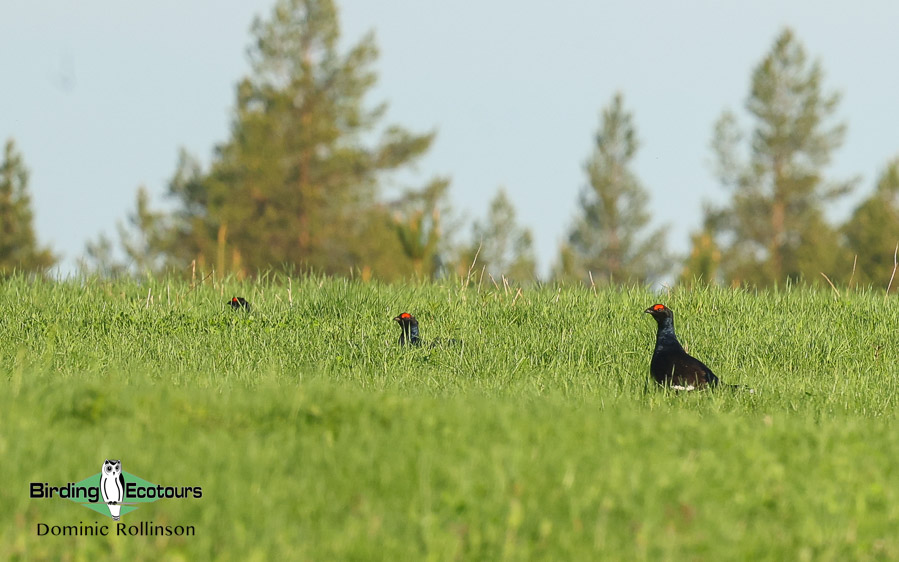
We will also spend time in the breathtaking old forests of the Oulanka National Park. Oulanka is the westernmost extreme of the taiga or boreal coniferous forest zone. In addition to the vast spruce forests, we can enjoy lichenous upland pine forests, wild river valleys, and watery mires. The flora and fauna of Oulanka’s river valley is a distinctive mix of northern, eastern, and southern species.
One of the true stars of the area is the Red-flanked Bluetail, for which we will walk up Valtavaara Hill, where the birds should be singing. While exploring the area we will attempt to see the often-elusive Hazel Grouse and Siberian Jay, and other highlights here could include Golden Eagle, White-throated Dipper, Red-necked Grebe, Little Gull, European Pied Flycatcher, and Common Redstart. If luck is on our side, we may also have an unforgettable encounter with (European) Brown Bear or Moose (confusingly called Elk in Europe!).
Overnight (three nights): Holiday Club Kuusamon, Tropiikki, Finland
Day 7. Crossing the Arctic Circle to Lapland, transfer to Ivalo
Today will be a travel day as we make the drive north from Kuusamo to Lapland, and the town of Ivalo. We will stop along the route, as we have done in previous days, to look for the area’s key species such as Eurasian Dotterel and Broad-billed Sandpiper.
Overnight: Hotel Ivalo, Ivalo, Finland
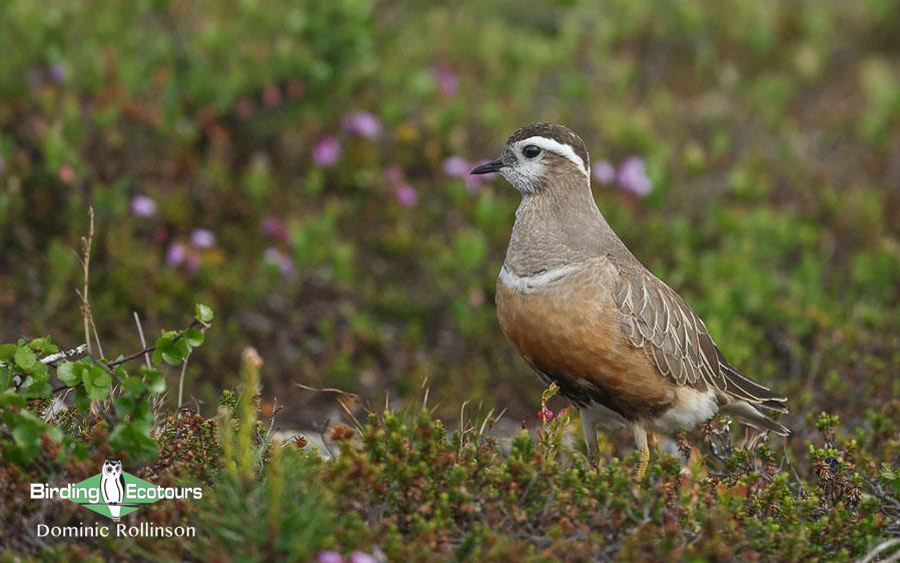
Day 8. Birding the Tana River, its delta in Norway and crossing the tundra to Båtsfjord
Today we will make another northward journey from Ivalo all the way to the northern edge of Europe on the Barents Sea. Along the way we will notice how the landscape begins to change with the vegetation becoming sparser as we move into tundra habitats. We start by exploring some superb pine forest and bog habitat. Here we will look for similar species to the previous days, such as Siberian Jay, Pine Grosbeak, and perhaps even Jack Snipe. As we move north, new species will start to reveal themselves.
As we approach the border with Norway the vast forests begin to give way to more expansive bogs. Here we should come across Black-throated Loon (Diver), Common Crane, Tufted Duck, Bluethroat, Rough-legged Buzzard, European Golden Plover, and Spotted Redshank. Other shorebirds in the area might include Temminck’s Stint, with its butterfly-like display flight, as well as Common Ringed Plover. We will also aim to watch a few spectacular male Ruffs at their lek sites. Differently colored males concentrate on winning the females’ attention in a dazzling display of color and movement, something not to be missed.
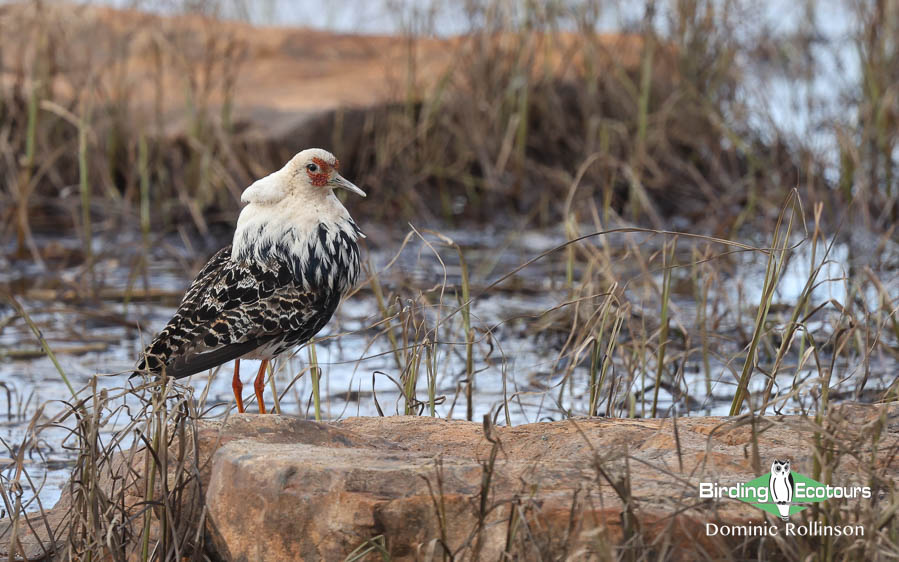
Next, we will drive along the Tana River and into Norway. The ancient deciduous woodland around the river is an excellent spot to look for Northern Hawk-Owl and woodland passerines. We will then visit the Tana River delta, which is famous for good numbers of Common Merganser (Goosander), Temminck’s Stint, and other breeding waders, plus Arctic Tern. The area is also productive for birds of prey, with Golden Eagle, Rough-legged Buzzard, Common Kestrel, Peregrine Falcon, and White-tailed Eagle all regular in the area.
The delta is also a good place to look for Harbor Seal, with the vast river deposits forming islands for them to rest on. These islands also make good loafing sites for birds such as Common Gull, European Herring Gull, Great Black-backed Gull, Great Cormorant, Northern Raven, Common Eider, Whooper Swan, and Barnacle Goose. Offshore we may spot passing Parasitic Jaeger (Arctic Skua), Pomarine Jaeger (Skua), and Long-tailed Jaeger (Skua).
From the Tana delta we once again head north and it is from this point that we will see the most dramatic change in habitat as we enter the true tundra region. As the road twists, turns and slowly begins to climb we will notice that the last of the trees will vanish and in front of us will emerge a vast area of high-altitude tundra, a vast rocky landscape broken up by small bogs and lakes. We will stop and explore the tundra area and experience the hardy birds that live here such as Rock Ptarmigan, Willow Ptarmigan, Merlin, Long-tailed Jaeger (Skua), Eurasian Whimbrel, Eurasian Dotterel, Lapland Longspur (Bunting), Temminck’s Stint, Red-necked Phalarope, Eurasian Golden Plover, Greater Scaup, and Long-tailed Duck. We may also come across Bluethroat, Horned (Shore) Lark and Lapland Longspur (Bunting), which spend the summer here. We will keep checking rare bird news for any reports of Snowy Owl which is occasionally seen in the area.
Overnight: Båtsfjord Hotel, Båtsfjord, Norway
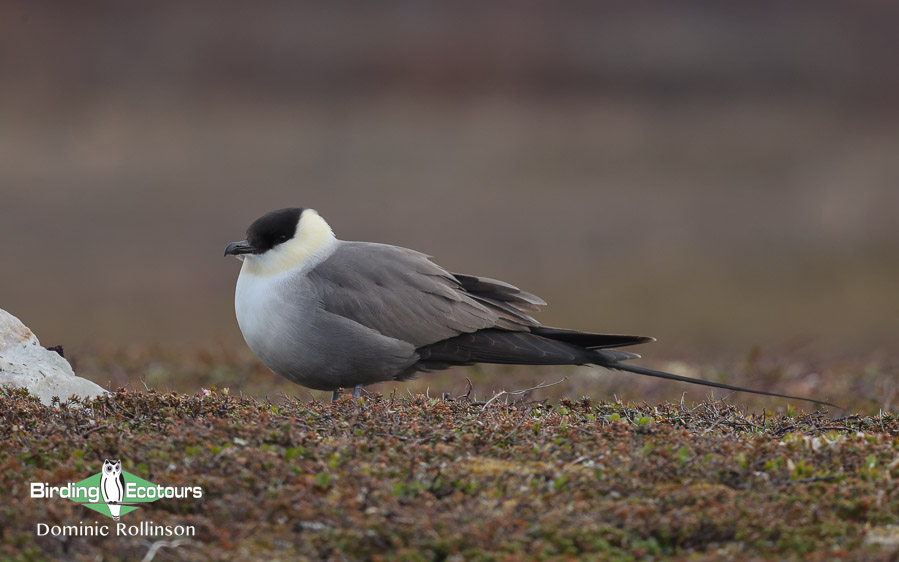
Days 9-10. The Varangerfjord and Hornøya
The next two days will be spent on the Varangerfjord. Our birding here will be a mixture of tundra walks, checking coastal bays and river inlets, sea-watching, and visiting the huge seabird colonies in the area. We will also search for the key mammals of the area, with the open tundra habitat home to Reindeer, Red Fox, Mountain Hare, and Arctic Fox (although this is now a rare mammal here).
The tundra exploration will be like that of the previous days, however being further south we should come across a bit more variety here as we move back to areas with a bit more tree cover. In these areas we may come across Rough-legged Buzzard, Bluethroat, Short-eared Owl, Arctic Redpoll, Common Redpoll, Horned (Shore) Lark, Snow Bunting, Lapland Longspur (Bunting), Fieldfare, Redwing, Brambling, and plenty of other species. We may also, once again, bump into Northern Hawk-Owl around the villages which lie adjacent to the fjord.
The high tundra off the Varangerfjord will see us come across the breeding territories of Long-tailed Jaeger (Skua), Parasitic Jaeger (Arctic Skua), Red-throated Loon (Diver), Black-throated Loon (Diver), Long-tailed Duck, and Red-necked Phalarope. Shorebirds (waders) breed in this area too with European Golden Plover, Eurasian Whimbrel, Wood Sandpiper, and Ruff, all in the higher areas.
Exploring the sheltered bays, river inlets, and harbors along the coast of the fjord will give us fantastic close-up views of several species of shorebirds, ducks, geese, seabirds, gulls, and terns. Some of the key species that we may come across include Purple Sandpiper, Red-necked Phalarope, Temminck’s Stint, Bar-tailed Godwit, Tundra Bean Goose, Northern Fulmar, Pink-footed Goose, Barnacle Goose, Velvet Scoter, Arctic Tern, Glaucous Gull, and occasionally Iceland Gull.
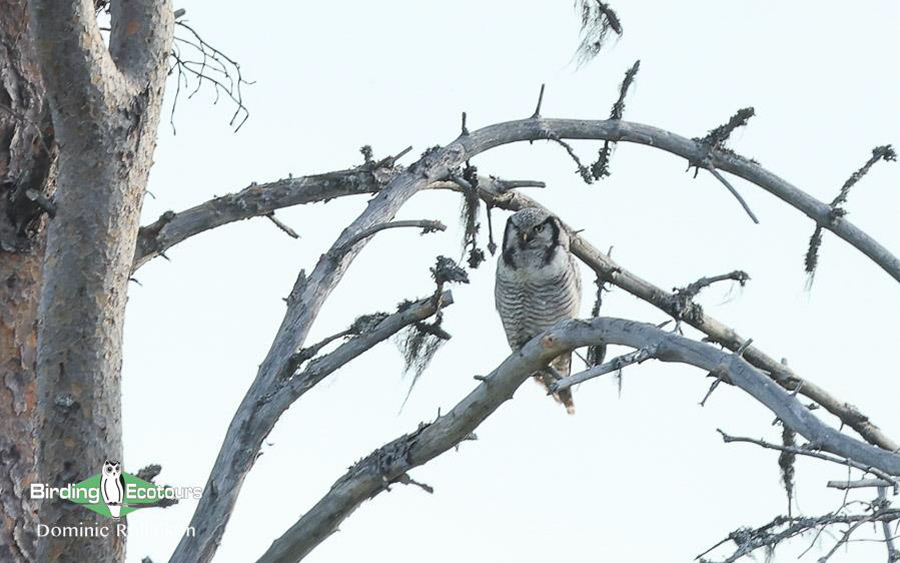
The real stars of these coastal sites are the large numbers of Common Eider which are present here through most of the summer. While common, their stardom comes from sometimes holding small numbers of the beautiful King Eider and Steller’s Eider within their flocks. While both these birds have declined in summer in recent years, we hope for some individuals to linger into June, and we will spend time looking for these rare and striking ducks.
While in the Varangerfjord we will make a boat excursion from the town of Vardø to the islet of Hornøya. The Hornøya Nature Reserve is the easternmost of the protected bird colonies in Norway, home to about 25,000 pairs of Black-legged Kittiwake and 150 pairs of European Shag. Northern alcids breeding here include Thick-billed Murre (Brünnich’s Guillemot), Common Murre (Guillemot), Razorbill, and several thousand pairs of Atlantic Puffin.
The relentless noise from the colony attracts birds of prey and corvids to the area and it is not uncommon to see hunting in action here. We may witness the giant White-tailed Eagle grabbing adult Black-legged Kittiwakes from the cliffs while Gyrfalcon may occasionally be seen while on the lookout for unsuspecting birds below! While watching and photographing the breeding seabirds of the islet we will also be on the lookout for European Rock Pipit and Twite which are normally found on the higher areas of the island, towards the lighthouse.
The Arctic waters are also home to Grey Seal and Harbor Seal, which we may see from the boat on the trip to or from the island. Cetaceans may be seen here too including Killer Whale (Orca), Humpback Whale, Harbor Porpoise, and on occasion, Beluga Whale.
We will also make an excursion towards Hamningberg, connected by road from Vardø. The wild landscape on the road to Hamningberg is something special. We may take several short walks to the tundra and to the bogs here. We will do some sea-watching south of Hamningberg, hoping to see Yellow-billed Loon (White-billed Diver), Northern Gannet, Northern Fulmar, Long-tailed Jaeger (Skua), Parasitic Jaeger (Arctic Skua), or even Beluga Whale.
Overnight (two nights): Hotel Vardø, Vardø, Norway
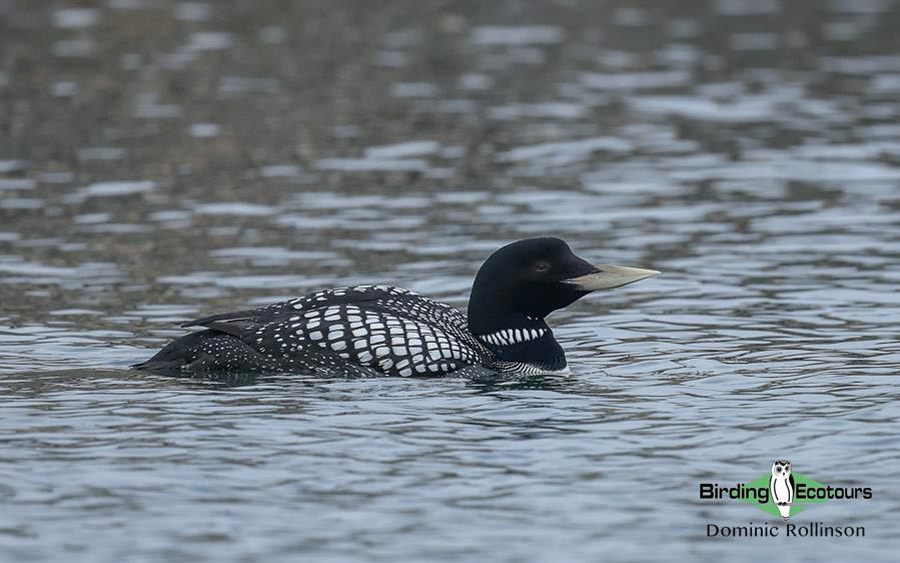
Day 11. Transfer to Ivalo
Today will mostly be a travel day as we make the drive south from Vardø in Norway back to Finland, and the town of Ivalo. We will stop along the route, as we have done in previous days, to look for any of the area’s missing key species. After our bird-filled days in the Arctic weather, we will retreat to our comfortable hotel in Ivalo.
Overnight: Hotel Ivalo, Ivalo, Finland
Day 12. Departure from Ivalo
Time permitting, we may bird in the morning before heading to Ivalo Airport for your flight home, or further connections.
Overnight: Not included
Please note that the itinerary cannot be guaranteed as it is only a rough guide and can be changed (usually slightly) due to factors such as availability of accommodation, updated information on the state of accommodation, roads, or birding sites, the discretion of the guides and other factors. In addition, we sometimes must use a different guide from the one advertised due to tour scheduling or other factors.
Download ItineraryFinland and Norway – Taiga and Tundra Trip Report
1 – 11 JUNE 2024
By Dominic Rollinson
DOWNLOAD TRIP REPORT
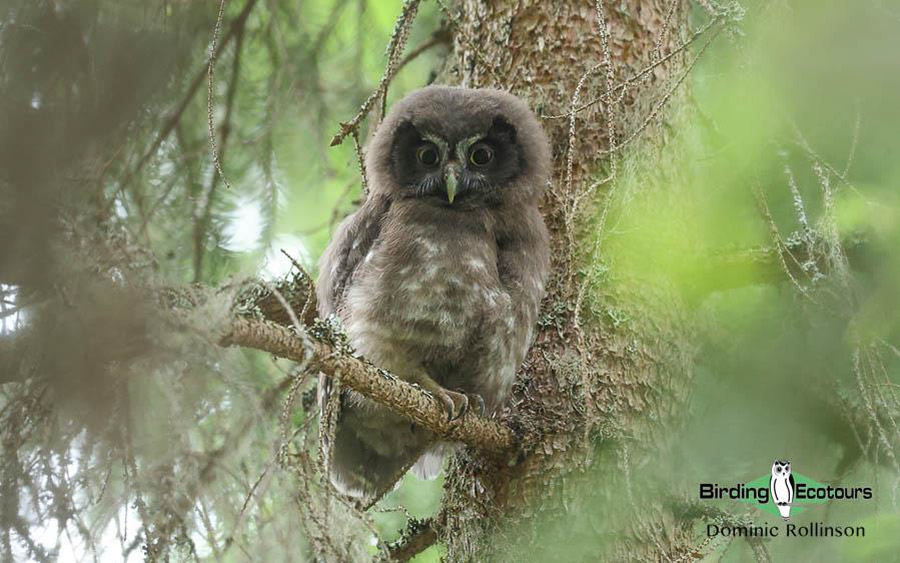
This juvenile Boreal (Tengmalm’s) Owl was an early tour highlight.
Overview
Our Finland and Norway: Taiga and Tundra birding tour was timed to coincide with the breeding season for a range of exciting Scandinavian species, with owls, grouse, breeding shorebirds and seabirds high on the agenda. With this trip taking place in early summer, it meant that we had 24 hours of daylight, and so, if we had the energy, we were able to bird late into the evening.
This trip took us from the vast taiga forests (also known as boreal forests) of central Finland north into Norway where we enjoyed time in the tundra of the Arctic Circle, also spending time birding on seabird breeding islands and along dramatic fjords. We started our Scandinavian adventure in Oulu (Finland) where we spent a few days birding in taiga forests and wetlands. Some of the highlights in this area included, most importantly, Eurasian Pygmy, Boreal and Ural Owls, as well as Black, Eurasian Three-toed, Lesser Spotted and Grey-headed Woodpeckers and an assortment of waterfowl such as Whooper Swan, Garganey, Northern Pintail, Common Scoter, Smew and Red-breasted and Common Mergansers.

This huge Ural Owl was seen well around Oulu.
We then moved north to the Kuusamo area where further taiga forest birding was enjoyed. Various grouse species were our primary targets in this area, and we managed to find Black and Hazel Grouse and Western Capercaillie, including a memorable encounter with a displaying male capercaillie. Other big targets here included Northern Hawk-Owl, Grey-headed Chickadee (Siberian Tit), Siberian Jay and Red-flanked Bluetail, which we all saw well.
Our journey continued northwards as we crossed into Norway and enjoyed a few days birding in the cold Arctic tundra, which offered a very different mix of bird species. Highlights during our time here included Willow and Rock Ptarmigans, Rough-legged Buzzard, Lapland Longspur, Arctic Redpoll and several species of breeding waders (shorebirds).
For our final few days of the tour, we moved to the picturesque Varangerfjord where we visited the seabird breeding island of Hornøya, enjoying point-blank views of impressive numbers of European Shag, Thick-billed and Common Murres, Razorbill and Atlantic Puffin. Further exploration of the tundra here delivered an Arctic Fox which was another major trip highlight. The tour then ended in Kirkenes after a successful and enjoyable eleven days of Scandinavian birding.

We could not have asked for better looks of European Shag on Hornøya island.
Unfortunately, we ended up missing some of the hoped-for owl species; with a pair of Great Grey Owls having abandoned their nest a couple weeks before our trip and Snowy Owl proving elusive. Finding owls in Scandinavia is very much reliant on vole abundance and, unfortunately, the summer of 2024 was not a particularly impressive vole year, which meant certain owl species were in lower densities this year.
Many thanks to our expert local guide and driver, Pirita, whose intricate knowledge of the area and supreme birding skills ensured we ended with an impressive bird list of 185 species. Thanks too to the tour participants, Murray, Sandra, Janette and Michael for helping make the trip the success it was.
Detailed Report
Day 1, 1st June 2024. Birding the Oulu area
With all tour participants having arrived the day before, we decided to make an earlier start to our birding. A prebreakfast walk around our well-positioned birding lodge, right on the edge of a bay of the Baltic Sea, started our list off nicely with Gadwall, Red-breasted Merganser, Common Goldeneye, Eurasian Curlew, Spotted Flycatcher and Common Rosefinch all seen nicely.
We met Pirita after breakfast and then loaded up into the van. Our first couple birding stops produced more good wetland and wetland edge species such as Eurasian Wigeon, Tufted Duck, Smew, Common Scoter and Ruff, with European Pied Flycatcher, Lesser Whitethroat and Garden Warbler seen in the nearby treed areas.
It was then time to target some owls and we went to our first Eurasian Pygmy Owl nest box, where the resident pair were not very cooperative, nevertheless, we did find European Honey Buzzard, Eurasian Sparrowhawk (which almost took our heads off as it shot by, chasing a bird), and Coal, Willow and Great Tits. The next pygmy owl nest site proved much more rewarding as, soon after arriving, we noticed an adult Eurasian Pygmy Owl watching us quietly from not too far above us. We enjoyed watching this tiny predator for a while, before pulling ourselves away to move onto our next birding spot.

Eurasian Pygmy Owl was seen well near Oulu.
Next up was a Black Woodpecker nest site, which took a while to show, but eventually we had lovely looks, as one of the adults came back to visit the breeding hole. Other good birds seen while waiting for the woodpecker included Great Spotted Woodpecker, Spotted Flycatcher and Eurasian Chaffinch.
We ended the day with another small owl species, this being a juvenile Boreal (Tengmalm’s) Owl, close to its nest site. We enjoyed watching this cute owl species for a while and then decided to move on and bird some other woods and fields nearby, which were mostly quiet. A small pond nearby held a very showy pair of Horned (Slavonian) Grebes and ended a highly productive first day of birding in Finland.
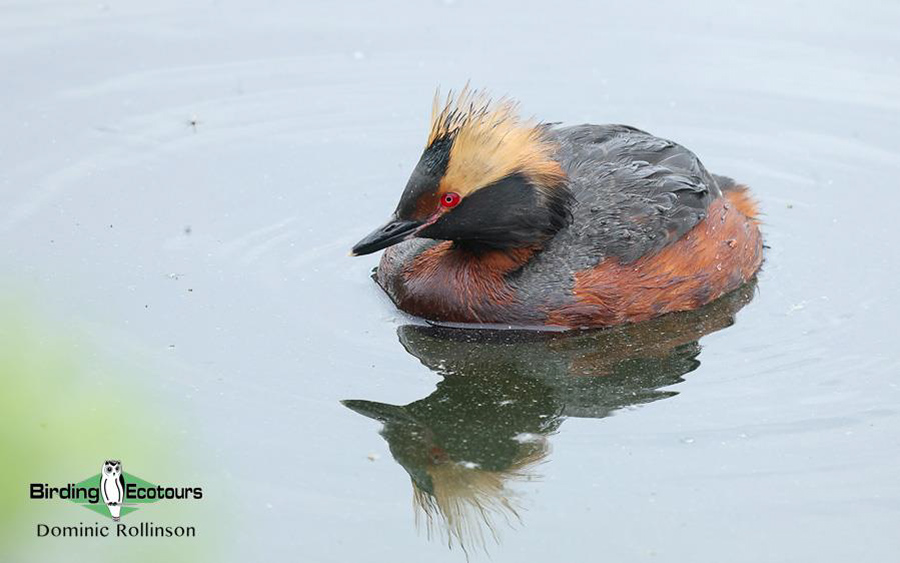
This Horned Grebe was another highlight of our first day.
Day 2, 2nd June 2024. Birding Oulu and surrounds
Another pre-breakfast birding walk from our hotel provided sightings of Garganey, Red-necked Grebe, Black-tailed Godwit, displaying Common Snipe, Western Marsh Harrier and European Pied Flycatcher.
After breakfast we loaded up into our van, with the first stop at a nearby lake adding lovely views of Common Scoter, with small numbers of Little Gulls seen feeding low over the water. In the surrounding area we had displaying Eurasian Skylarks and singing Yellowhammers while, a little further afield, a roadside stop added Common Crane, Whinchat, Common Whitethroat, Common Linnet and our first Redwing of the trip.
Our next stop was Virkkula birdwatching tower, on the shores of Liminka Bay, which was full of birds. Here we found a good selection of waterbirds, including Mute Swan, Garganey, Northern Shoveler, Eurasian Teal, Common and Spotted Redshanks, Common Greenshank, Common Gull, Common Tern, Whinchat and Meadow Pipit. We enjoyed a hearty lunch in the visitor center and then took a walk around the impressive bird exhibit, where we prepped on some of the birds we were hoping to see on this trip.
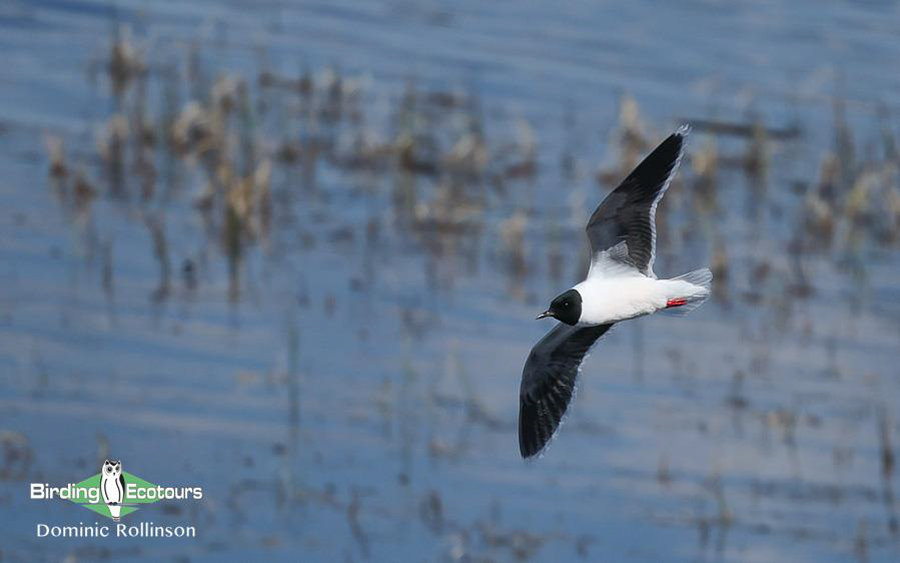
Attractive Little Gulls were seen on lakes around Oulu.
Later that afternoon we visited a nest site of a pair of massive Urals Owls. It didn’t take too long before we spotted the female guarding her nest and, with some careful manoeuvring, we positioned ourselves to enjoy unobstructed views from a safe distance. This was a highly memorable experience as we enjoyed prolonged scope views, with a Rustic Bunting heard calling nearby, which unfortunately would not show itself. On our way back to our hotel, we made a quick stop at a small wetland where we heard the distant boom of a Eurasian Bittern, before calling it a day.
Day 3, 3rd June 2024. Further Oulu birding
Our pre-breakfast birding walk did not produce too much different from the previous two mornings, although a small flock of Common Cranes were a nice addition. Over breakfast, Michael reported that he had seen a bird he was pretty certain was an Arctic Warbler and so, after breakfast, we visited a particular patch of trees. The warbler duly obliged, and we were able to add this species to our list. This was likely an early (and slightly out-of-place) migrant, heading towards its breeding grounds further north.
We then moved a little north of Oulu, where we targeted Eurasian Wryneck, which did not take long to show itself. Sadly, the calling Goldcrests would not show for us. We then moved around the corner to an industrial park where, right on cue, we heard the song of Terek Sandpiper, which landed on its well-used perch and gave us prolonged scope views. It seemed a bizarre site for this wader to breed, however, they had used this site for the previous few years and were seemingly quite happy here.
After the excitement of the Terek Sandpiper, we moved to a nearby spot of dense woodlands, where we spent the next couple of hours birding and eking out a few warblers and other cryptic species. We had to work for all our sightings here but eventually we added Greenish and Garden Warblers, Red-breasted Flycatcher and a showy Northern Wheatear. We tried a nearby stakeout for Thrush Nightingale and, despite hearing it singing, we could not lay eyes on this skulker. Another patch of woodlands held a trio of Eurasian Treecreepers and a very showy pair of Wood Warblers.

Wood Warblers brightened up the woodlands around Oulu.
After lunch, we moved to a mature patch of taiga forest, where we were after a few woodpecker species. Eurasian Three-toed Woodpecker showed easily in its nest hole, with Lesser Spotted Woodpecker proving easy too. Grey-headed Woodpecker proved tricky though and, after trying for a while (and fighting off the worst mosquitoes of the trip), we decided to pack it in and try again the following morning, on our way out of Oulu.
The day ended with a brief Eurasian Woodcock flyby, after having narrowly missing this species on a few occasions over the last few days.
Day 4, 4th June 2024. Oulu birding and transfer to Kuusamo
We weren’t in any particular rush to leave the Oulu area this morning and so we birded some farmlands, which held Eurasian Tree Sparrow, Ortolan Bunting and Eurasian Skylark. We then decided to give the Grey-headed Woodpecker another shot, which thankfully obliged today after a fairly short wait.
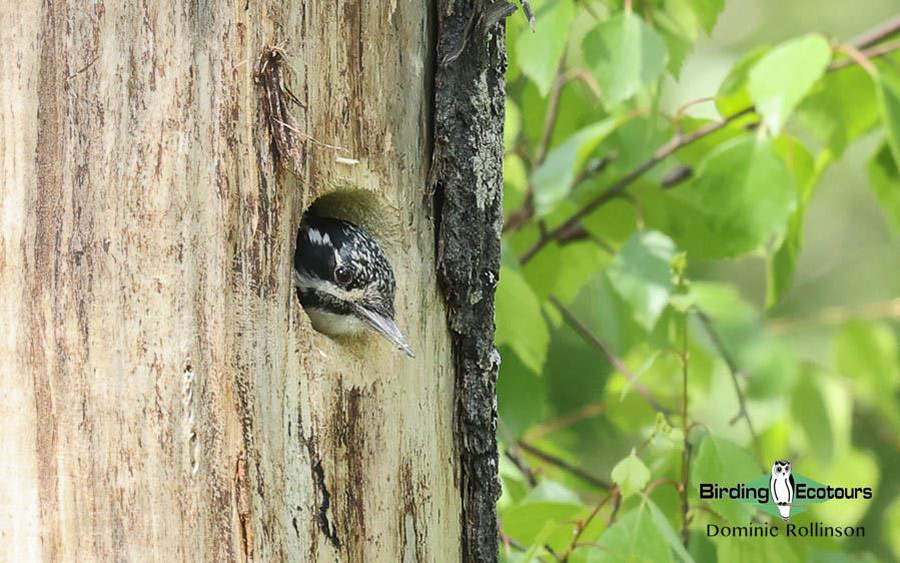
Woodpeckers, such as this Eurasian Three-toed Woodpeckers, were another tour highlight.
The drive for today would only take us around three hours, so we decided to bird along the way, making a series of short stops for certain species. As we made our way northwest out of Oulu we stopped off in some mature taiga forest, where we soon found Crested Tit and Tree Pipit,while a bog further north added Taiga Bean Goose, Common Crane and Western Yellow Wagtail. A small lake held Little Gull, Western Yellow Wagtail and our first Black-throated Loon of the tour.
Before arriving at our hotel in Kuusamo we made one last stop for the day, adding an obliging Grey-headed Chickadee (Siberian Tit), a big tour target. This was a lifer for Michael and was number 4000 for his world list; that evening we enjoyed champagne celebrations!
Day 5, 5th June 2024. Taiga forest birding around Kuusamo
We didn’t let the celebrations go on too late last night, since we had a 3:30 am departure to go look for lekking grouse! An early start was required because the grouse stop lekking when the day gets too hot. We arrived on site in an area where Western Capercaillie regularly lek and, within a few minutes, we spotted a male and watched him strut around, seemingly unphased by our presence. Male capercaillies can be extremely aggressive at their leks, thankfully, this bird didn’t bother us!
After an incredible 30 minutes or so with the capercaillie, we moved on to go look for Black Grouse. , Unfortunately all their regular lek sites were empty and we decided it was probably a little too warm for them. Despite this, we had some wonderful birding this morning and were delighted to find Velvet Scoter, Hazel Grouse (brief flight views), Red Crossbill, Taiga Bean Goose (improved views), Common Crane, Common Snipe, Eurasian Siskin and another two Western Capercaillies! Good numbers of Mountain Hares were seen this morning too!

It was wonderful to watch this lekking male Western Capercaillie near Kuusamo.
We enjoyed our breakfast (always tastes better with capercaillie in the bag!) and then took some time off after our very early start. Later that morning we loaded up into the van and birded some nearby wetlands for the rest of the morning. The birding was a little slower (than the early morning outing at least) but we did manage to find Red-necked Grebe, Little Gull, Arctic Tern, Wood Sandpiper, Black-throated Loon, Sand Martin and a Little Bunting in some nearby scrub. We were excited to find another male Western Capercaillie quietly walking in the undergrowth; a nice catch-up bird for Janette and Sandra who had not joined in the early morning.
After our lunch we took a drive east towards the Russian border where we managed to find Merlin, Black Kite, Northern Raven (a very distant bird), Brambling, and Mistle Thrush. Another good sighting this afternoon was brief looks at an Ermine (Stoat). We ended a little earlier this afternoon as we had another early start the next morning to target lekking Black Grouse!
Day 6, 6th June 2024. Kuusamo birding
Our alarms were again set early and we left our hotel at 3:30 am and made our way towards some classic Black Grouse lekking sites. We arrived at the first site and immediately spotted as many as nine male Black Grouse which were busy defending prime lekking spots. We enjoyed watching them through the scope before we moved on to look for more targets. One of the major highlights (and surprises) of the morning was a sighting of a pair of Northern Hawk-Owls which we noticed flying across the road, carrying prey. Pirita suspected there was likely a nest nearby and it didn’t take long before we spotted three chicks sat in a tree. In the same area as the hawk-owls, we saw another group of lekking Black Grouse. After the excitement of the hawk-owls we made our way to a forested hill near Oulanka National Park, where we saw a few singing male Red-flanked Bluetails,as well as Goldcrest, Eurasian Bullfinch, Brambling, Eurasian Siskin and improved our views of Hazel Grouse.

This Northern Hawk-Owl was a lovely find around Kuusamo.
It was another enjoyable breakfast (this time revelling in our hawk-owl sighting) and then we had some more time off to catch up on some sleep. We then loaded up into the van again. We spent most of the rest of the day birding in and around Oulanka National Park. A quick stop for dippers proved a fun one as we found a couple begging juvenile White-throated Dippers and a Grey Wagtail. We did a riverside walk in the hopes of finding Parrot Crossbill but had to settle with Spotted Flycatcher, White Wagtail and Eurasian Siskin, before we enjoyed a tasty lunch.
We were still missing Siberian Jay and so decided to work some conifer forests on the drive back to Kuusamo. The forest was quiet but after a while we heard them calling and got some nice looks at another important trip target. Before getting back into Kuusamo, we stopped at the Northern Hawk-Owl site, where we again enjoyed prolonged views; another nice catch-up bird for Sandra and Janette.
Day 7, 7th June 2024. Transfer to Ivalo
Today was mostly a travel day, as we made our way north to Ivalo in northern Finland. Before we hit the road properly, we birded some taiga woodlands where we again saw Siberian Jay. We then started the journey north and enjoyed a traditional shot of liqueur as we crossed the Arctic Circle. In the late afternoon we birded some moorland on the slopes of Saariselka where, after a long search, we found Eurasian Dotterel which provided fantastic views. Other birds seen during our search included European Golden Plover, Common Ringed Plover and Meadow Pipit.

This confiding Eurasian Dotterel put on a wonderful show for us.
Day 8, 8th June 2024. Transfer to Norway and tundra birding
Before leaving the taiga forests near Ivalo we had another look for Rustic Bunting but had to settle for a showy Little Bunting. We then visited some bird feeders near Kaamenen, which were alive with birds. Here, we had point-blank views of Pine Grosbeak, Brambling, Eurasian Bullfinch, European Greenfinch and Common Redpoll, as we enjoyed a hot drink and a bite to eat. A couple showy Eurasian Red Squirrels were fun to watch here too.
As we continued to make our way north the vegetation began to thin out and a couple roadside stops added Bluethroat, Northern Raven and Eurasian Whimbrel. We stopped at a bog where Broad-billed Sandpipers are known to breed but as we stopped, the heavens unfortunately opened, and we decided to retreat to the vehicle.
After lunch we crossed into Norway and birded alongside the Tana River and the Tana River Delta. The birding here was excellent and we found many new birds, such as Common Eider, Bar-tailed Godwit, Temminck’s Stint, Dunlin and Parasitic Jaeger.
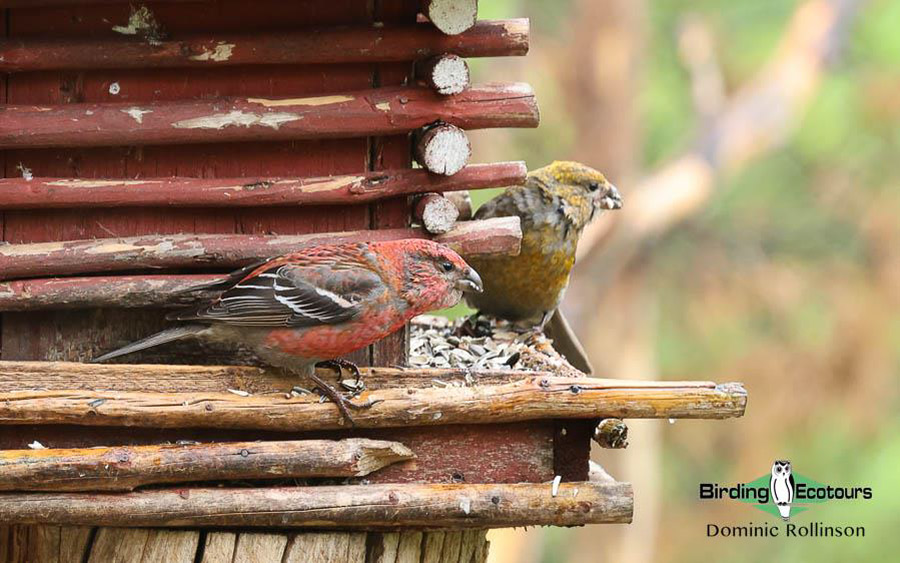
Pine Grosbeak were seen at bird feeders near Kaamenen.
For most of the remainder of the afternoon, we slowly made our way through the Arctic tundra of the highlands, which again proved incredibly productive (although very chilly)! We enjoyed watching lekking Ruffs, displaying Temminck’s Stints and Willow and Rock Ptarmigans and small flocks of Arctic Redpolls. We made a stop at a roadside lake which held Eurasian Teal, Long-tailed Duck, Common Merganser, Greater Scaup, Long-tailed Jaeger, Red-throated Loon, European Golden Plover, Common Snipe, Red-necked Phalarope and more lekking Ruffs.
After a long day, we eventually arrived in Batsfjord, where we checked in and enjoyed our dinner. After dinner we took a drive to an area where a Snowy Owl had been seen a few days prior. Despite a good search we could not locate the owl and had to settle for decent looks at a Rough-legged Buzzard.
Day 9, 9th June 2024. Tundra birding and transfer to Varangerfjord
After breakfast we packed the van and made our way back through the highlands, where we were still missing a few tundra specials. Ring Ouzel, Horned Lark, Snow Bunting and Lapland Longspur did not take too long to find, with more Rock and Willow Ptarmigans, Bluethroat and Long-tailed Jaeger again seen in the area.
We then made our way back to the coast and followed the coastline as we headed east. Our picnic lunch stop was a picturesque one as we sat watching waders such as Little Stints, Eurasian Oystercatchers and Bar-tailed Godwits.
We continued to make our way along the coastline and a number of birding stops further added Tundra Bean Goose, Great Black-backed Gull, Ruddy Turnstone, Red Knot, Curlew and Purple Sandpipers and Common Redshank.
Large flocks of Common Eider were carefully scanned and eventually we managed to pick out both Steller’s and King Eiders – two major targets on this tour. Within these flocks we also picked out Common Scoter, Long-tailed Duck and Common and Red-breasted Mergansers.
In the late afternoon we made our way onto the island of Vardø (via the underwater tunnel) and decided to take it easy for the remainder of the afternoon .
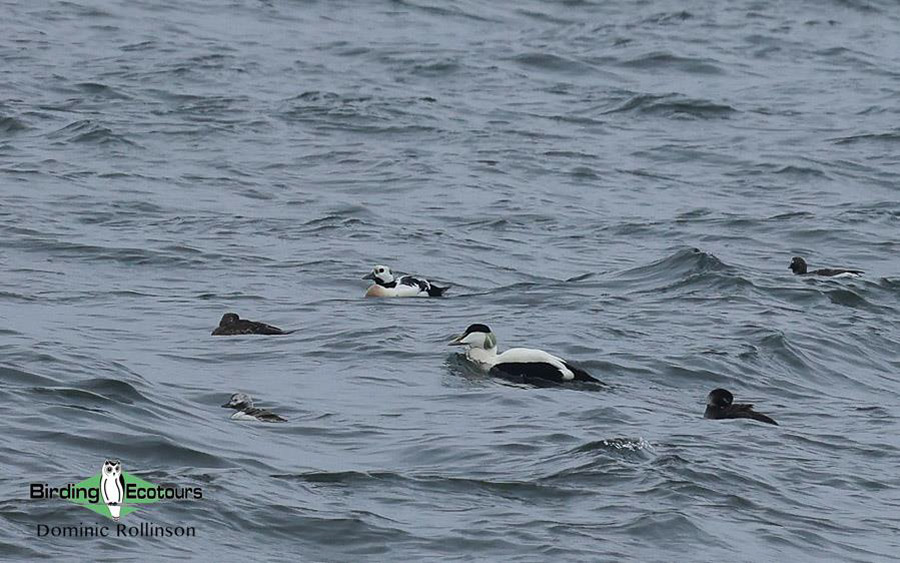
After a bit of a search we eventually found Steller’s Eider in amongst the Common Eider flocks.
Day 10, 10th June 2024. Hornøya and Vardø birding
Today was the final full day of the tour and we decided to have a more leisurely morning, with a stroll around the town. Black-legged Kittiwakes were breeding on most of the buildings around town, while a quiet secluded bay held a stunning Yellow-billed Loon. We also found a few Red-throated Pipits in some nearby fields.
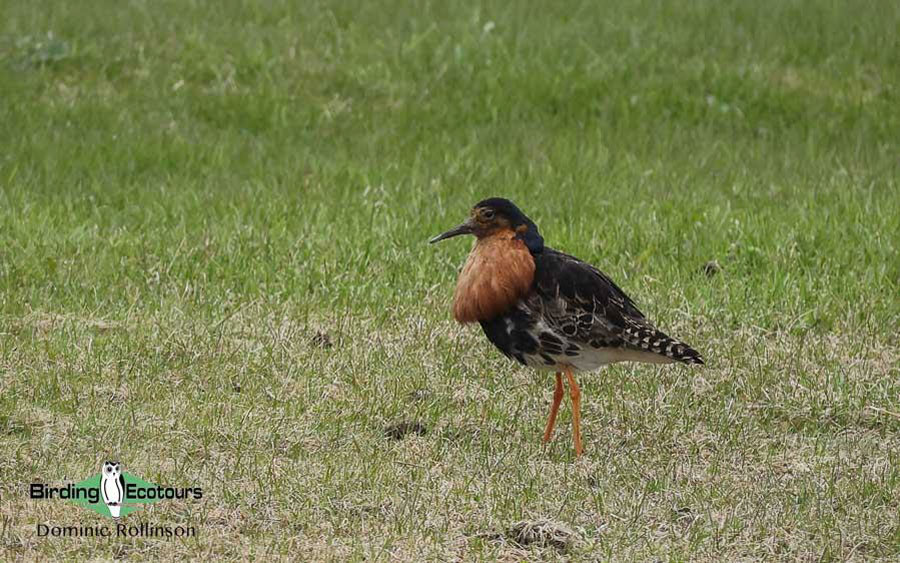
Lekking male Ruff of all varieties were widespread in Finland and Norway.
After breakfast we took the short boat trip to Hornøya island, which is packed full of breeding seabirds. We then spent an enjoyable couple of hours wandering in amongst breeding European Shags, Thick-billed and Common Murres, Atlantic Puffins, Razorbills and Black-legged Kittiwakes. Barnacle Geese also made a couple flybys.
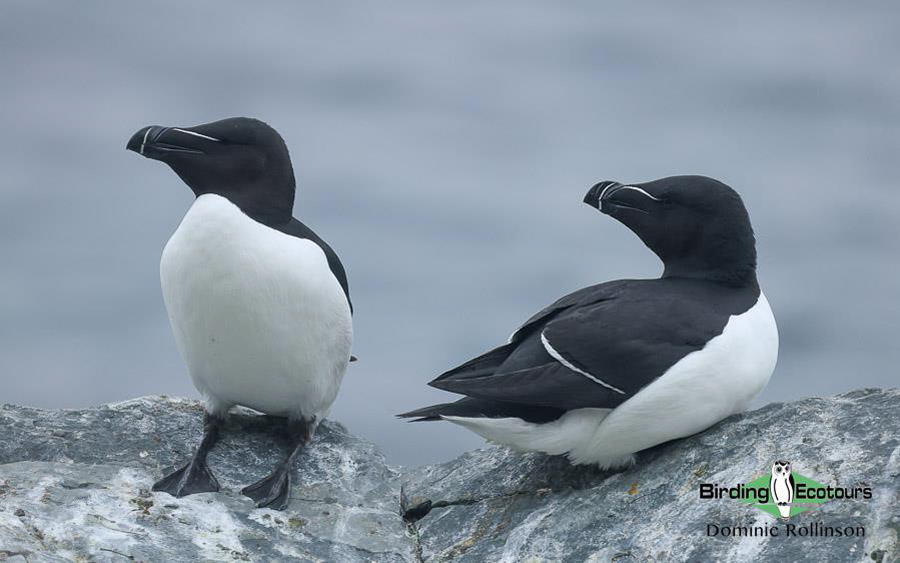
Razorbills were seen well on Hornøya island.
After a wonderful fish lunch we took a drive back through the tunnel and onto the mainland, which was a little on the quiet side, although did produce many White-tailed Eagle sightings. The highlight of the afternoon was a single Arctic Fox.

This Yellow-billed Loon was particularly confiding on Vardo.
Day 11, 11th June 2024. Transfer to Kirkenes and departure
With late morning flights scheduled, we had to get moving early and, thankfully, the drive to Kirkenes was uneventful, with just a few White-tailed Eagles being the most noteworthy species. The tour ended at Kirkenes Airport, where we said our goodbyes after a fantastic eleven days of birding in Finland and Norway.
Bird List – Following IOC December 2023
Birds ‘heard only’ are marked with (H) after the common name, all other species were seen both by clients and guide. The following notation after species names is used to show conservation status following IUCN List of Threatened Species. VU = Vulnerable.
| Common name | Scientific name |
| Ducks, Geese, Swans (Anatidae) | |
| Barnacle Goose | Branta leucopsis |
| Greylag Goose | Anser anser |
| Taiga Bean Goose | Anser fabalis |
| Tundra Bean Goose | Anser serrirostris |
| Mute Swan | Cygnus olor |
| Whooper Swan | Cygnus cygnus |
| Common Shelduck | Tadorna tadorna |
| Garganey | Spatula querquedula |
| Northern Shoveler | Spatula clypeata |
| Gadwall | Mareca strepera |
| Eurasian Wigeon | Mareca penelope |
| Mallard | Anas platyrhynchos |
| Northern Pintail | Anas acuta |
| Eurasian Teal | Anas crecca |
| Tufted Duck | Aythya fuligula |
| Greater Scaup | Aythya marila |
| Steller’s Eider – VU | Polysticta stelleri |
| King Eider | Somateria spectabilis |
| Common Eider | Somateria mollissima |
| Velvet Scoter – VU | Melanitta fusca |
| Common Scoter | Melanitta nigra |
| Long-tailed Duck – VU | Clangula hyemalis |
| Common Goldeneye | Bucephala clangula |
| Smew | Mergellus albellus |
| Common Merganser | Mergus merganser |
| Red-breasted Merganser | Mergus serrator |
| Pheasants & Allies (Phasianidae) | |
| Hazel Grouse | Tetrastes bonasia |
| Willow Ptarmigan | Lagopus lagopus |
| Rock Ptarmigan | Lagopus muta |
| Western Capercaillie | Tetrao urogallus |
| Black Grouse | Lyrurus tetrix |
| Common Pheasant | Phasianus colchicus |
| Swifts (Apodidae) | |
| Common Swift | Apus apus |
| Cuckoos (Cuculidae) | |
| Common Cuckoo | Cuculus canorus |
| Pigeons, Doves (Columbidae) | |
| Rock Dove | Columba livia |
| Common Wood Pigeon | Columba palumbus |
| Eurasian Collared Dove | Streptopelia decaocto |
| Cranes (Gruidae) | |
| Common Crane | Grus grus |
| Grebes (Podicipedidae) | |
| Red-necked Grebe | Podiceps grisegena |
| Great Crested Grebe | Podiceps cristatus |
| Horned Grebe – VU | Podiceps auritus |
| Oystercatchers (Haematopodidae) | |
| Eurasian Oystercatcher | Haematopus ostralegus |
| Plovers (Charadriidae) | |
| European Golden Plover | Pluvialis apricaria |
| Eurasian Dotterel | Eudromias morinellus |
| Common Ringed Plover | Charadrius hiaticula |
| Northern Lapwing | Vanellus vanellus |
| Sandpipers, Snipes (Scolopacidae) | |
| Eurasian Whimbrel | Numenius phaeopus |
| Eurasian Curlew | Numenius arquata |
| Bar-tailed Godwit | Limosa lapponica |
| Black-tailed Godwit | Limosa limosa |
| Eurasian Woodcock | Scolopax rusticola |
| Common Snipe | Gallinago gallinago |
| Red-necked Phalarope | Phalaropus lobatus |
| Terek Sandpiper | Xenus cinereus |
| Common Sandpiper | Actitis hypoleucos |
| Wood Sandpiper | Tringa glareola |
| Common Redshank | Tringa totanus |
| Spotted Redshank | Tringa erythropus |
| Common Greenshank | Tringa nebularia |
| Ruddy Turnstone | Arenaria interpres |
| Red Knot | Calidris canutus |
| Ruff | Calidris pugnax |
| Curlew Sandpiper | Calidris ferruginea |
| Temminck’s Stint | Calidris temminckii |
| Sanderling | Calidris alba |
| Dunlin | Calidris alpina |
| Purple Sandpiper | Calidris maritima |
| Little Stint | Calidris minuta |
| Gulls, Terns, Skimmers (Laridae) | |
| Caspian Tern | Hydroprogne caspia |
| Arctic Tern | Sterna paradisaea |
| Common Tern | Sterna hirundo |
| Little Gull | Hydrocoloeus minutus |
| Black-legged Kittiwake – VU | Rissa tridactyla |
| Black-headed Gull | Chroicocephalus ridibundus |
| Common Gull | Larus canus |
| European Herring Gull | Larus argentatus |
| Great Black-backed Gull | Larus marinus |
| Lesser Black-backed Gull | Larus fuscus |
| Skuas (Stercorariidae) | |
| Long-tailed Jaeger | Stercorarius longicaudus |
| Parasitic Jaeger | Stercorarius parasiticus |
| Auks (Alcidae) | |
| Atlantic Puffin – VU | Fratercula arctica |
| Black Guillemot | Cepphus grylle |
| Razorbill | Alca torda |
| Thick-billed Murre | Uria lomvia |
| Common Murre | Uria aalge |
| Loons (Gaviidae) | |
| Red-throated Loon | Gavia stellata |
| Black-throated Loon | Gavia arctica |
| Yellow-billed Loon | Gavia adamsii |
| Petrels, Shearwaters, Diving Petrels (Procellariidae) | |
| Northern Fulmar | Fulmarus glacialis |
| Gannets, Boobies (Sulidae) | |
| Northern Gannet | Morus bassanus |
| Cormorants, Shags (Phalacrocoracidae) | |
| Great Cormorant | Phalacrocorax carbo |
| European Shag | Gulosus aristotelis |
| Herons, Bitterns (Ardeidae) | |
| Eurasian Bittern (H) | Botaurus stellaris |
| Kites, Hawks, Eagles (Accipitridae) | |
| European Honey Buzzard | Pernis apivorus |
| Eurasian Sparrowhawk | Accipiter nisus |
| Western Marsh Harrier | Circus aeruginosus |
| Black Kite | Milvus migrans |
| White-tailed Eagle | Haliaeetus albicilla |
| Rough-legged Buzzard | Buteo lagopus |
| Owls (Strigidae) | |
| Boreal Owl | Aegolius funereus |
| Northern Hawk-Owl | Surnia ulula |
| Eurasian Pygmy Owl | Glaucidium passerinum |
| Ural Owl | Strix uralensis |
| Woodpeckers (Picidae) | |
| Eurasian Wryneck | Jynx torquilla |
| Eurasian Three-toed Woodpecker | Picoides tridactylus |
| Lesser Spotted Woodpecker | Dryobates minor |
| Great Spotted Woodpecker | Dendrocopos major |
| Black Woodpecker | Dryocopus martius |
| Grey-headed Woodpecker | Picus canus |
| Caracaras, Falcons (Falconidae) | |
| Common Kestrel | Falco tinnunculus |
| Merlin | Falco columbarius |
| Crows, Jays (Corvidae) | |
| Siberian Jay | Perisoreus infaustus |
| Eurasian Jay | Garrulus glandarius |
| Eurasian Magpie | Pica pica |
| Western Jackdaw | Coloeus monedula |
| Rook | Corvus frugilegus |
| Hooded Crow | Corvus cornix |
| Northern Raven | Corvus corax |
| Tits, Chickadees (Paridae) | |
| Coal Tit | Periparus ater |
| Crested Tit | Lophophanes cristatus |
| Grey-headed Chickadee | Poecile cinctus |
| Willow Tit | Poecile montanus |
| Eurasian Blue Tit | Cyanistes caeruleus |
| Great Tit | Parus major |
| Larks (Alaudidae) | |
| Eurasian Skylark | Alauda arvensis |
| Horned Lark | Eremophila alpestris |
| Swallows, Martins (Hirundinidae) | |
| Sand Martin | Riparia riparia |
| Barn Swallow | Hirundo rustica |
| Western House Martin | Delichon urbicum |
| Leaf Warblers (Phylloscopidae) | |
| Wood Warbler | Phylloscopus sibilatrix |
| Willow Warbler | Phylloscopus trochilus |
| Common Chiffchaff (H) | Phylloscopus collybita |
| Greenish Warbler | Phylloscopus trochiloides |
| Arctic Warbler | Phylloscopus borealis |
| Reed Warblers & Allies (Acrocephalidae) | |
| Sedge Warbler | Acrocephalus schoenobaenus |
| Sylviid Babblers (Sylviidae) | |
| Garden Warbler | Sylvia borin |
| Lesser Whitethroat | Curruca curruca |
| Common Whitethroat | Curruca communis |
| Goldcrests, Kinglets (Regulidae) | |
| Goldcrest | Regulus regulus |
| Treecreepers (Certhiidae) | |
| Eurasian Treecreeper | Certhia familiaris |
| Starlings, Rhabdornises (Sturnidae) | |
| Common Starling | Sturnus vulgaris |
| Thrushes (Turdidae) | |
| Song Thrush (H) | Turdus philomelos |
| Mistle Thrush | Turdus viscivorus |
| Redwing | Turdus iliacus |
| Common Blackbird | Turdus merula |
| Fieldfare | Turdus pilaris |
| Ring Ouzel | Turdus torquatus |
| Chats, Old World Flycatchers (Muscicapidae) | |
| Spotted Flycatcher | Muscicapa striata |
| European Robin (H) | Erithacus rubecula |
| Thrush Nightingale (H) | Luscinia luscinia |
| Bluethroat | Luscinia svecica |
| Red-breasted Flycatcher | Ficedula parva |
| European Pied Flycatcher | Ficedula hypoleuca |
| Red-flanked Bluetail | Tarsiger cyanurus |
| Common Redstart | Phoenicurus phoenicurus |
| Whinchat | Saxicola rubetra |
| Northern Wheatear | Oenanthe oenanthe |
| Dippers (Cinclidae) | |
| White-throated Dipper | Cinclus cinclus |
| Old World Sparrows, Snowfinches (Passeridae) | |
| Eurasian Tree Sparrow | Passer montanus |
| House Sparrow | Passer domesticus |
| Accentors (Prunellidae) | |
| Dunnock (H) | Prunella modularis |
| Wagtails, Pipits (Motacillidae) | |
| Western Yellow Wagtail | Motacilla flava |
| Grey Wagtail | Motacilla cinerea |
| White Wagtail | Motacilla alba |
| Meadow Pipit | Anthus pratensis |
| Tree Pipit | Anthus trivialis |
| Red-throated Pipit | Anthus cervinus |
| Finches, Euphonias (Fringillidae) | |
| Eurasian Chaffinch | Fringilla coelebs |
| Brambling | Fringilla montifringilla |
| Pine Grosbeak | Pinicola enucleator |
| Eurasian Bullfinch | Pyrrhula pyrrhula |
| Common Rosefinch | Carpodacus erythrinus |
| European Greenfinch | Chloris chloris |
| Common Linnet | Linaria cannabina |
| Common Redpoll | Acanthis flammea |
| Arctic Redpoll | Acanthis hornemanni |
| Red Crossbill | Loxia curvirostra |
| Eurasian Siskin | Spinus spinus |
| Longspurs, Snow Buntings (Calcariidae) | |
| Lapland Longspur | Calcarius lapponicus |
| Snow Bunting | Plectrophenax nivalis |
| Buntings (Emberizidae) | |
| Yellowhammer | Emberiza citrinella |
| Ortolan Bunting | Emberiza hortulana |
| Little Bunting | Emberiza pusilla |
| Rustic Bunting – VU (H) | Emberiza rustica |
| Common Reed Bunting | Emberiza schoeniclus |
| Species Seen | 178 |
| Species heard only | 7 |
| Total species recorded | 185 |
Mammal List – Following Mammalwatching.com (April 2024)
| Common name | Scientific name |
| Hares and Rabbits (Leporidae) | |
| European Hare | Lepus europaeus |
| Mountain Hare | Lepus timidus |
| Squirrels (Sciuridae) | |
| Eurasian Red Squirrel | Sciurus vulgaris |
| Hamsters, Voles, Lemmings, and Allies (Cricetidae) | |
| Eurasian Water Vole | Arvicola amphibius |
| Mustelids (Mustelidae) | |
| Beringian Ermine | Mustela erminea |
| Earless Seals (Phocidae) | |
| Gray Seal | Halichoerus grypus |
| Harbor Seal | Phoca vitulina |
| Canids (Canidae) | |
| Arctic Fox | Vulpes lagopus |
| Deer (Cervidae) | |
| Western Roe Deer | Capreolus capreolus |
| Caribou – VU | Rangifer tarandus |
| Species Seen | 10 |
DOWNLOAD TRIP REPORT
This is a sample trip report. Please email us ([email protected]) for more trip reports from this destination.
Useful information
During this tour, your guide will be driving you in a comfortable vehicle. The tour does require some walking and hiking to see certain species of birds and there are opportunities for longer hikes if you wish. Some of these walks and hikes will be on rough, steep terrain so please make sure you are of a good level of fitness for this tour.
Due to the costs involved with visiting Scandinavia we run this tour with a slightly larger group than we would to other destinations so that we can spread the cost and keep costs down for everyone involved. This decision is also based on the habitats we will be birding in on the tour which allow for larger groups, without reducing the experience of the tour.
The weather in the area can also be highly variable with day temperatures often ranging from 25oC to -8oC in this period depending on the wind strength and direction. Nights are frequently cold and as the sun does not set, many of our excursions will occur later into the evening and early morning.
The forested areas will have noticeable populations of biting insects if the weather is warm so please ensure you bring some form of repellent with you. Despite the northern latitudes, the sun here can be strong in summer, so a hat and sun block are advised.
‘About Finland I can tell you that we had very good opportunities to take photos. We got superb photos of species such as Western Capercaillie, Black Grouse, Hazel Grouse, Great Grey Owl, Ural Owl, Northern Hawk Owl, Pygmy-Owl, Short-eared Owl, Common Goldeneye, Whooper Swan, Common Crane, Parrot Crossbill, Red-flanked Blue-tail, Rustic Bunting, Red-breasted Merganser, Red-necked Grebe, Siberian Jay, Siberian Tit, Willow Tit, Honey-buzzard, Temminck’s Stint, Common Redshank, Baltic and Little Gulls, Eurasian Jackdaw, Hooded Crow, Arctic Tern, Common Cuckoo, Three-toed Woodpecker and Pied Flycatcher.
We also took nice photos of Dotterel, Black-throated Diver, Ruff, Sedge and Icterine Warblers, Red-breasted Flycatcher, Fieldfare, Eurasian Wryneck, Common Redpoll and some other birds.
We missed Terek Sandpiper (we saw it but we can’t take any photos) but another group took very good photos of it before we arrived to the place where the bird was.
To me, it has been an excellent trip to take photographs, plenty of good chances. Undoubtedly it has been the best trip I have made ever in Europe from this point of view.’
Luis and Belen
